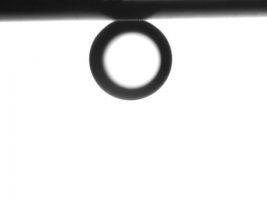Researchers of Aalto University have developed new surface materials that are extremely difficult to wet both by water and oil. Because they don’t need isolating air to stay trapped between the droplet and rough surface to prevent wetting, these surface materials work even when wet by another liquid. Researchers’ novel dual super lyophobic surfaces repel water even when covered by oil and oil when covered by water. So far, this has been regarded as contradictory to each other and not expected to be present on the same surface.
If you drop some water on your new Teflon pan, drops can’t hold firmly anywhere. The pan does not get wet but droplet rebounds in the shape of pancake. Drop some oil on the pan and it stays there better because oil, unlike water, slightly wets the surface.
Researchers of Aalto University have developed new surface materials that are extremely difficult to wet both by water and oil. Because they don’t need isolating air to stay trapped between the droplet and rough surface to prevent wetting, these surface materials work even when wet by another liquid.
Researchers’ novel dual superlyophobic surfaces repel water even when covered by oil and oil when covered by water. So far, this has been regarded as contradictory to each other and not expected to be present on the same surface.
Several ways to apply
“The competitive interaction with surfaces between oil and water plays an essential role in various technological applications. Our new design strategy of surfaces can be used in many ways from self-cleaning to dirt-repellency,” tells Xuelin Tian, who was a postdoctoral researcher in Aalto University before recently becoming a professor at Sun Yat-sen University, China.
Liquid-repellent surfaces are very important for several industries. For instance, the extreme oil repellency under water can be utilized in marine industry to fight against fouling, including oil contamination and biofouling by organisms. On the other hand, the extreme water repellency of the surfaces when covered by oil are also a great help against corrosion: moisture is effectively inhibited and corrosion can be reduced.
Such surfaces can be regarded as an environment-responsive material which means its surface wettability changes with the environmental liquid it contacts. Unlike other responsive surfaces, the new surface does not rely on reconfigurable organic molecular modification, and thus offers a new strategy to make smart materials. When processed in the form of porous materials, it may be used for separation of both water-in-oil and oil-in-water emulsions, whereas common oil/water separation materials work for one type of emulsion only, says Assistant Professor Robin Ras from Aalto University.





